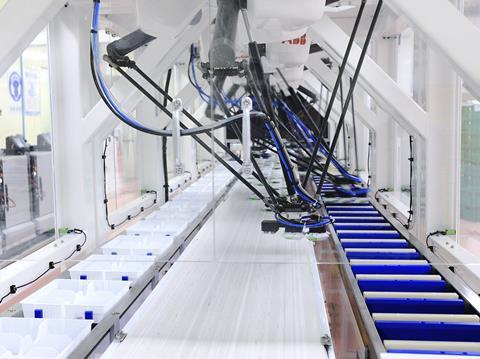
The technological and social revolutions of the past few decades have completely reshaped industry. The food packaging and palletising industry is no exception. In fact, the last ten years alone has seen the adoption of advanced technologies at an unprecedented rate. Here, Alan Spreckley, robotics food and beverage segment manager and palletising robotics expert at ABB, explains how digitalisation is repackaging the future of food palletising.
The last two decades have seen a decline in the nuclear family and a global rise in the number of private households with only a single occupier. In 2017, the UK office of national statistics (ONS) conducted a study that found 27.8 per cent of UK households had only one inhabitant. Likewise, the labour force survey (LFS) showed that one-third of European households are single person, while the US has been experiencing a significant increase of single person households since the 1920s.
This growing trend places a higher demand for single-portion servings of pre-prepared and pre-packaged food on the food industry, which makes the packaging and palletising processes less linear than they have previously been. Similarly, the unstable economy of recent years has nurtured a generation of savvy customers, eager for the special offers and deals that retailers regularly provide, further complicating the palletising process. This leads to scenarios where manufacturers will be required to change palletising patterns quickly and cost efficiently to deliver this.
Virtual commissioning
Robots have been a staple of the food industry since the 1980s, with most businesses using at least one robotic system for some part of the production line. Palletising robots have proven particularly popular among plant engineers as they increase productivity, improve working conditions and can be easily integrated into existing production systems.
However, the process of integrating palletising robots has traditionally relied on computer assisted design (CAD) drawings and involved a lot of estimation.
To quicken this step, virtual commissioning is becoming increasingly popular among plant managers, often using ABB’s innovative suite of virtual commissioning tools. Instead of using CAD, the process is modelled in 3D which provides an accurate visualisation of a factory layout. This allows plant engineers to see a digital representation of how the robot will integrate and move within the process and allows them to discover and resolve any potential technical issues before they become a reality, reducing commissioning time by up to 25 per cent.
Real-time offline programming
While developments such as virtual commissioning and remote monitoring technologies both keep factories running, it is the offline programming software that yields efficiency benefits for plant managers. This is software that allows the remote programming of palletising robots without interrupting production.
For example, if a retailer usually asks for four-packs of tinned soup but decides to offer a 50 per cent-extra-free offer, the palletising robot will be required to change palletising patterns accordingly. Failure to do this effectively could result in businesses being unable to supply a sufficient amount of product to retailers, which leads to lost contracts and the risk of heavy supplier fines.
Plant managers can prevent this by digitally reprogramming palletising robots using offline software such as ABB’s RobotStudio, which can be accessed using a standard PC to change palletising patterns. This reduces the time taken to change over and boosts overall productivity to ensure that demands are met.
In the nineteenth and twentieth centuries, the automotive sector was one of the most technologically advanced and adaptive industries. If the past decade is anything to go by, the food industry is quickly building a similar reputation. By thinking more about digital solutions to production problems, plant managers can ensure that food processing becomes the automotive industry of the modern age, easily coping with the demands of the nuclear family and single occupier households.

















